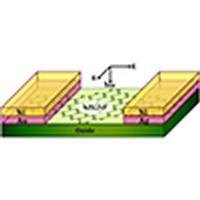当前位置:
X-MOL 学术
›
J. Opt. Soc. Amer. B
›
论文详情
Our official English website, www.x-mol.net, welcomes your
feedback! (Note: you will need to create a separate account there.)
Molecular spin–photovoltaic device based on a graphene nanoflake
Journal of the Optical Society of America B ( IF 1.8 ) Pub Date : 2020-02-06 , DOI: 10.1364/josab.375695 Sara Zamani , Rouhollah Farghadan
Journal of the Optical Society of America B ( IF 1.8 ) Pub Date : 2020-02-06 , DOI: 10.1364/josab.375695 Sara Zamani , Rouhollah Farghadan

|
We generate a spin-polarized current in a hexagonal zigzag graphene nanoflake (hZGNF) by integrating the photovoltaic and spin-dependent transport effects. We consider three different hZGNF configurations and simulate their spin–photovoltaic properties using two probe models in the presence of ferromagnetic contacts as well as the magnetization of zigzag edges. Our results reveal acceptable spin-dependent quantum efficiency, full optical spin polarization, and good optically induced magnetoresistance up to 900%, which can be modified by adjusting the photon energy, by varying the configuration, and also by introducing monovacancy. Interestingly, switching the magnetization of ferromagnetic contacts can approximately invert the spin characteristic of the photocurrent, and so the sign of optical spin polarization. Our findings may provide an efficient way to enhance radiation-induced magnetoresistance in carbon-based molecular junctions.
中文翻译:

基于石墨烯纳米薄片的分子自旋光伏器件
我们通过整合光伏和自旋相关的传输效应,在六边形之字形石墨烯纳米片(hZGNF)中产生自旋极化电流。我们考虑了三种不同的hZGNF配置,并在铁磁接触以及锯齿形边缘磁化的情况下,使用两个探针模型模拟了它们的自旋光伏特性。我们的结果表明可接受的自旋相关量子效率,完全的光学自旋极化以及高达900%的良好的光感应磁阻,可以通过调节光子能量,改变结构以及引入单空位来进行修改。有趣的是,切换铁磁触点的磁化强度可以大致反转光电流的自旋特性,因此也可以逆转光学自旋极化的信号。
更新日期:2020-03-02
中文翻译:

基于石墨烯纳米薄片的分子自旋光伏器件
我们通过整合光伏和自旋相关的传输效应,在六边形之字形石墨烯纳米片(hZGNF)中产生自旋极化电流。我们考虑了三种不同的hZGNF配置,并在铁磁接触以及锯齿形边缘磁化的情况下,使用两个探针模型模拟了它们的自旋光伏特性。我们的结果表明可接受的自旋相关量子效率,完全的光学自旋极化以及高达900%的良好的光感应磁阻,可以通过调节光子能量,改变结构以及引入单空位来进行修改。有趣的是,切换铁磁触点的磁化强度可以大致反转光电流的自旋特性,因此也可以逆转光学自旋极化的信号。











































 京公网安备 11010802027423号
京公网安备 11010802027423号